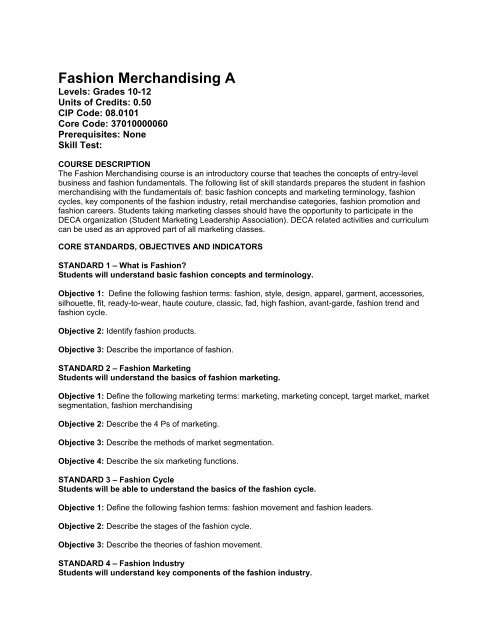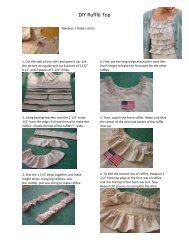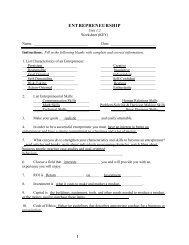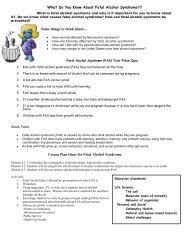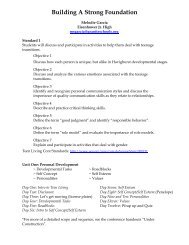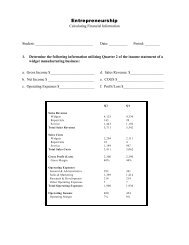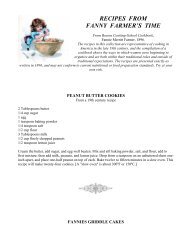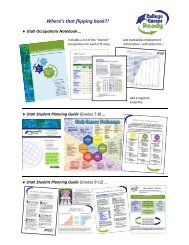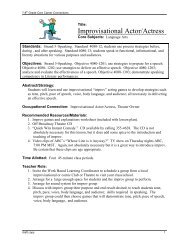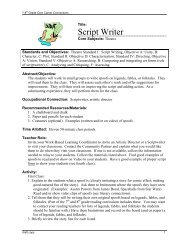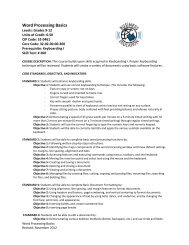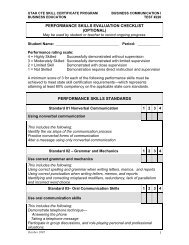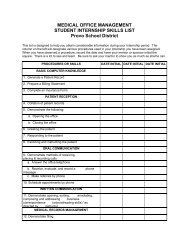Fashion Merchandising A
Fashion Merchandising A
Fashion Merchandising A
Create successful ePaper yourself
Turn your PDF publications into a flip-book with our unique Google optimized e-Paper software.
<strong>Fashion</strong> <strong>Merchandising</strong> A<br />
Levels: Grades 10-12<br />
Units of Credits: 0.50<br />
CIP Code: 08.0101<br />
Core Code: 37010000060<br />
Prerequisites: None<br />
Skill Test:<br />
COURSE DESCRIPTION<br />
The <strong>Fashion</strong> <strong>Merchandising</strong> course is an introductory course that teaches the concepts of entry-level<br />
business and fashion fundamentals. The following list of skill standards prepares the student in fashion<br />
merchandising with the fundamentals of: basic fashion concepts and marketing terminology, fashion<br />
cycles, key components of the fashion industry, retail merchandise categories, fashion promotion and<br />
fashion careers. Students taking marketing classes should have the opportunity to participate in the<br />
DECA organization (Student Marketing Leadership Association). DECA related activities and curriculum<br />
can be used as an approved part of all marketing classes.<br />
CORE STANDARDS, OBJECTIVES AND INDICATORS<br />
STANDARD 1 – What is <strong>Fashion</strong>?<br />
Students will understand basic fashion concepts and terminology.<br />
Objective 1: Define the following fashion terms: fashion, style, design, apparel, garment, accessories,<br />
silhouette, fit, ready-to-wear, haute couture, classic, fad, high fashion, avant-garde, fashion trend and<br />
fashion cycle.<br />
Objective 2: Identify fashion products.<br />
Objective 3: Describe the importance of fashion.<br />
STANDARD 2 – <strong>Fashion</strong> Marketing<br />
Students will understand the basics of fashion marketing.<br />
Objective 1: Define the following marketing terms: marketing, marketing concept, target market, market<br />
segmentation, fashion merchandising<br />
Objective 2: Describe the 4 Ps of marketing.<br />
Objective 3: Describe the methods of market segmentation.<br />
Objective 4: Describe the six marketing functions.<br />
STANDARD 3 – <strong>Fashion</strong> Cycle<br />
Students will be able to understand the basics of the fashion cycle.<br />
Objective 1: Define the following fashion terms: fashion movement and fashion leaders.<br />
Objective 2: Describe the stages of the fashion cycle.<br />
Objective 3: Describe the theories of fashion movement.<br />
STANDARD 4 – <strong>Fashion</strong> Industry<br />
Students will understand key components of the fashion industry.
Objective 1: Identify factors that contributed to the development of the apparel industry.<br />
Objective 2: Identify key fashion centers in the U.S. and around the world.<br />
Objective 3: Identify and describe major trade publications and fashion magazines.<br />
Objective 4: Identify key fashion designers and their contributions: Giorgio Armani, Pierre Cardin, Coco<br />
Chanel, Christian Dior, Dolce and Gabanna, Tom Ford, Marc Jacobs, Donna Karan, Calvin Klein, Karl<br />
Lagerfeld, Ralph Lauren, Yves St Laurent, Levi Strauss, Versace (Gianni and Donnatella), Diane von<br />
Furstenberg, and Vera Wang.<br />
Objective 5: Identify key fashion awards.<br />
STANDARD 5 – <strong>Fashion</strong> Retail and Promotion<br />
Student will understand forms of fashion retail and promotion.<br />
Objective 1: Describe the following types of fashion retailing: department stores, flagship stores,<br />
specialty stores, boutiques, chain stores, designer stores, outlets, discount stores, mail order houses,<br />
online and television retailers.<br />
Objective 2: Identify the types of fashion promotion including: advertising, publicity, sales promotion,<br />
personal selling, and visual merchandising.<br />
STANDARD 6 – <strong>Fashion</strong> Careers<br />
Students will understand different types of career opportunities in the fashion industry.<br />
Objective 1: Describe key careers in the textile industry.<br />
Objective 2: Describe key careers in the fashion promotion industry.<br />
Objective 3: Describe key careers in the design and manufacturing industry.<br />
Objective 4: Describe key careers in the retail industry.


